
The Tet Offensive was a major escalation and one of the largest military campaigns of the Vietnam War. The Viet Cong (VC) and North Vietnamese People's Army of Vietnam (PAVN) launched a sneak attack on January 30, 1968, against the forces of the South Vietnamese Army of the Republic of Vietnam (ARVN), the United States Armed Forces and their allies. It was a campaign of surprise attacks against military and civilian command and control centers throughout South Vietnam. The name is the truncated version of the Lunar New Year festival name in Vietnamese, Tết Nguyên Đán, with the offense chosen during a holiday period as most ARVN personnel were on leave. The purpose of the wide-scale offensive by the Hanoi Politburo was to trigger political instability, in a belief that mass armed assault on urban centers would trigger defections and rebellions.

The Battle of Khe Sanh was conducted in the Khe Sanh area of northwestern Quảng Trị Province, Republic of Vietnam, during the Vietnam War. The main US forces defending Khe Sanh Combat Base (KSCB) were two regiments of the United States Marine Corps supported by elements from the United States Army and the United States Air Force (USAF), as well as a small number of Army of the Republic of Vietnam (ARVN) troops. These were pitted against two to three divisional-size elements of the North Vietnamese People's Army of Vietnam (PAVN).

Force Reconnaissance (FORECON) is a United States Marine Corps special operations forces which supplies military intelligence to the command element of the Marine Air-Ground Task Force (MAGTF). Force Reconnaissance companies unlike USMC division reconnaissance report to the Marine expeditionary force (MEF) and provide direct action and deep reconnaissance during large-scale operations.

The Civilian Irregular Defense Group was a military program developed by the Central Intelligence Agency (CIA) during the Vietnam War, which was intended to develop South Vietnamese irregular military units from indigenous ethnic-minority populations. The main purpose of setting up the CIDG program was to counter the growing influence of Viet Cong (VC) in the Central Highlands by training and arming the villagers for village defense. The program rapidly expanded after the US military transferred its control from CIA to MACV after two years since its inception and changed its focus from village defense to more conventional operations. From June 1967 onwards the CIDG members were made part of the Army of the Republic of Vietnam (ARVN) or other government agencies to increase Vietnamese participation. By late 1970, the remaining CIDG camps were converted to Vietnamese Rangers camps. The indigenous ethnic-minority people that formed the CIDG reaped significant benefits by the government of South Vietnam for their allegiance and it was the first time that minority groups were given full status as citizens of South Vietnam.
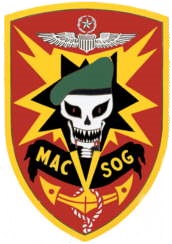
Military Assistance Command, Vietnam – Studies and Observations Group (MACV-SOG) was a highly classified, multi-service United States special operations unit which conducted covert unconventional warfare operations before and during the Vietnam War.
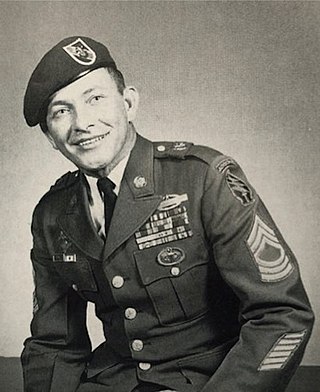
William Dawson Waugh was a United States Army Special Forces soldier and Central Intelligence Agency paramilitary operations officer who served more than 50 years between the U.S. Army's Green Berets and the CIA's Special Activities Division.

John L. Plaster is a former United States Army Special Forces officer regarded as one of the leading sniper experts in the world. A decorated Vietnam War veteran who served in the covert Studies and Observations Group (SOG), Plaster co-founded a renowned sniper school that trains military and law enforcement personnel in highly specialized sniper tactics. He is the author of The Ultimate Sniper: An Advanced Training Manual for Military and Police Snipers, The History of Sniping and Sharpshooting, and Secret Commandos: Behind Enemy Lines with the Elite Warriors of SOG, a memoir of his 3 years of service with SOG.
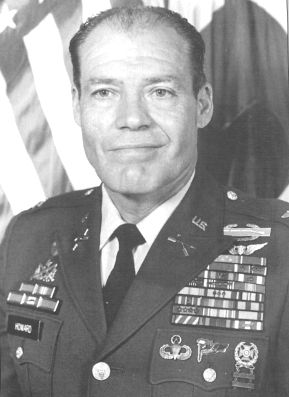
Robert Lewis Howard was the most highly decorated officer of Vietnam United States Army Special Forces and Medal of Honor recipient of the Vietnam War.
The Special Forces Association (SFA) is a non-profit fraternal organization for current and retired U.S. Army Special Forces soldiers, also known as "Green Berets." Established in 1964, the association is based at Fort Bragg, North Carolina, with 84 chapters located in the United States as well as Panama, South Korea, Germany, Thailand, Philippines and Okinawa. Chapters meet in their respective areas and conduct meetings, hold reunions and host social functions for their members.
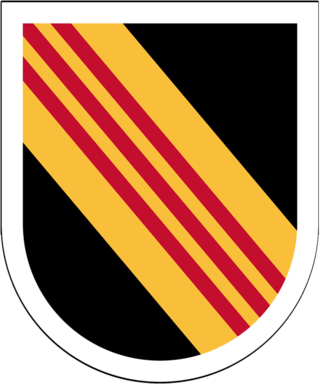
The 5th Special Forces Group (Airborne) (5th SFG (A), 5th Group) is one of the most decorated active duty United States Army Special Forces groups. The 5th SFG (A) saw extensive action in the Vietnam War and played a pivotal role in the early months of Operation Enduring Freedom. 5th Group is designed to deploy and execute nine doctrinal missions: unconventional warfare, foreign internal defense, direct action, counter-insurgency, special reconnaissance, counter-terrorism, information operations, counterproliferation of weapon of mass destruction, and security force assistance.

Franklin Douglas "Doug" Miller was an American and United States Army Special Forces staff sergeant during the Vietnam War who was awarded the United States military's highest decoration—the Medal of Honor—for his actions above and beyond the call of duty on January 5, 1970. He was also awarded a Silver Star, two Bronze Stars, and six Purple Hearts during his six years service in Southeast Asia.
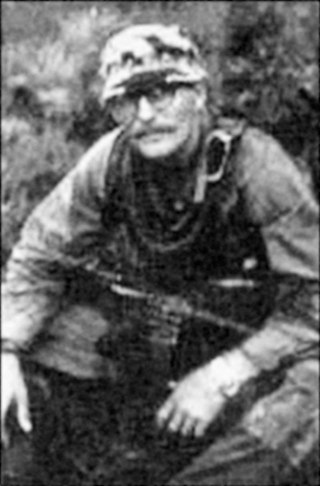
Loren Douglas Hagen was a United States Army Special Forces officer and a recipient of the United States military's highest decoration—the Medal of Honor—for his actions during the Vietnam War as Recon Team (RT) leader of a small special reconnaissance unit "RT Kansas", manned by USASF Green Berets and highly trained Montagnard commandos from Task Force One Advisory Element aka Command & Control North, a division of Studies and Observations Group in the Vietnam War. Hagen was the last member of the U.S. Army to earn a Medal of Honor in the Vietnam War.

The Army of the Republic of Vietnam Special Forces were the elite military units of the Army of the Republic of Vietnam (ARVN). Following the establishment of the Republic of Vietnam in October 1955, the Special Forces were formed at Nha Trang in February 1956. During the rule of Ngô Đình Diệm, the Special Forces were run by his brother, Ngô Đình Nhu, until both were assassinated in November 1963 in a coup. The Special Forces were disbanded in 1975 when South Vietnam ceased to exist after the Fall of Saigon.

A Hatchet Force or Hatchet Team was a special operations team of American and South Vietnamese members of MACV-SOG during the Vietnam War, who operated in small covert operations along the Ho Chi Minh trail from 1966. The units specialized in search and destroy missions and in locating missing American servicemen in Laos, Cambodia and North Vietnam.
Project DELTA was the first of the Reconnaissance Projects, which were special reconnaissance (SR) units named with a Greek letter. The Reconnaissance Projects were formed by the U.S. Military Assistance Command, Vietnam (MACV) during the Vietnam War to collect operational intelligence in remote areas of South Vietnam.

John Stryker "Tilt" Meyer is an American author and U.S. Army Special Forces combat veteran of service in covert reconnaissance with the Studies and Observations Group, also known as MACV-SOG. Meyer has published three works of nonfiction related to his experiences in the Vietnam War; the first was Across the Fence: The Secret War in Vietnam published in 2003.
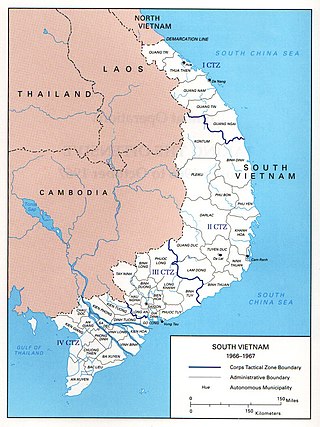
During the Cold War in the 1960s, the United States and South Vietnam began a period of gradual escalation and direct intervention referred to as the "Americanization" of joint warfare in South Vietnam during the Vietnam War. At the start of the decade, United States aid to South Vietnam consisted largely of supplies with approximately 900 military observers and trainers. After the assassination of both Ngo Dinh Diem and John F. Kennedy close to the end of 1963 and Gulf of Tonkin incident in 1964 and amid continuing political instability in the South, the Lyndon Johnson Administration made a policy commitment to safeguard the South Vietnamese regime directly. The American military forces and other anti-communist SEATO countries increased their support, sending large scale combat forces into South Vietnam; at its height in 1969, slightly more than 400,000 American troops were deployed. The People's Army of Vietnam and the allied Viet Cong fought back, keeping to countryside strongholds while the anti-communist allied forces tended to control the cities. The most notable conflict of this era was the 1968 Tet Offensive, a widespread campaign by the communist forces to attack across all of South Vietnam; while the offensive was largely repelled, it was a strategic success in seeding doubt as to the long-term viability of the South Vietnamese state. This phase of the war lasted until the election of Richard Nixon and the change of U.S. policy to Vietnamization, or ending the direct involvement and phased withdrawal of U.S. combat troops and giving the main combat role back to the South Vietnamese military.
George Washington Bacon III was an American soldier and intelligence officer. He served as a Green Beret in the U.S. Army, Paramilitary Officer in the Central Intelligence Agency (CIA), and finally as a mercenary soldier.
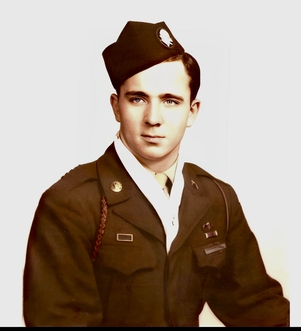
Theodore Burdette Braden, Jr. (1928–2007) was a Special Forces commando during the Vietnam War, master skydiver, and a suspect in the D.B. Cooper hijacking.
























